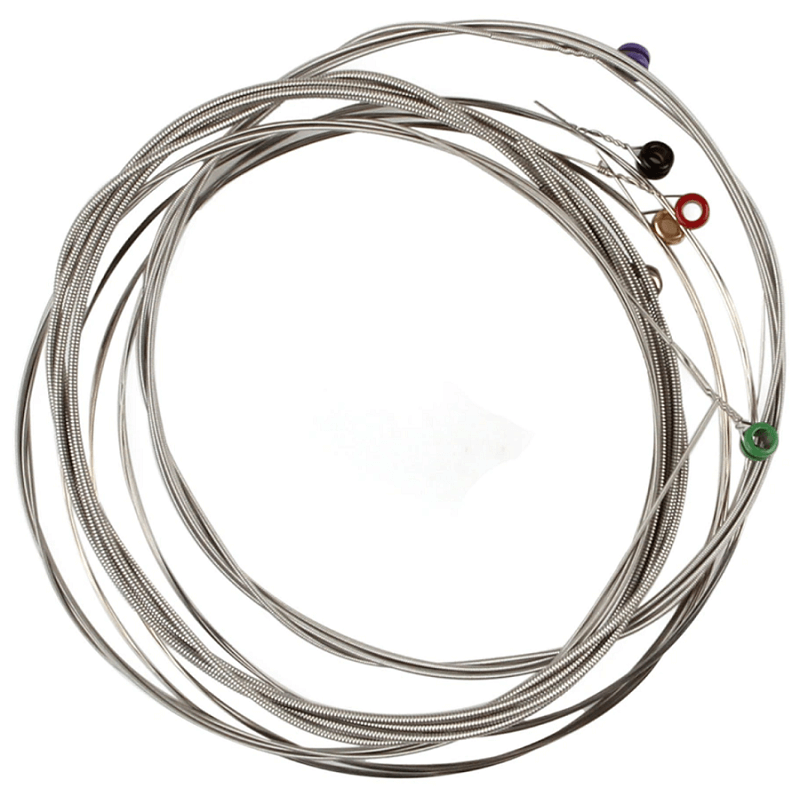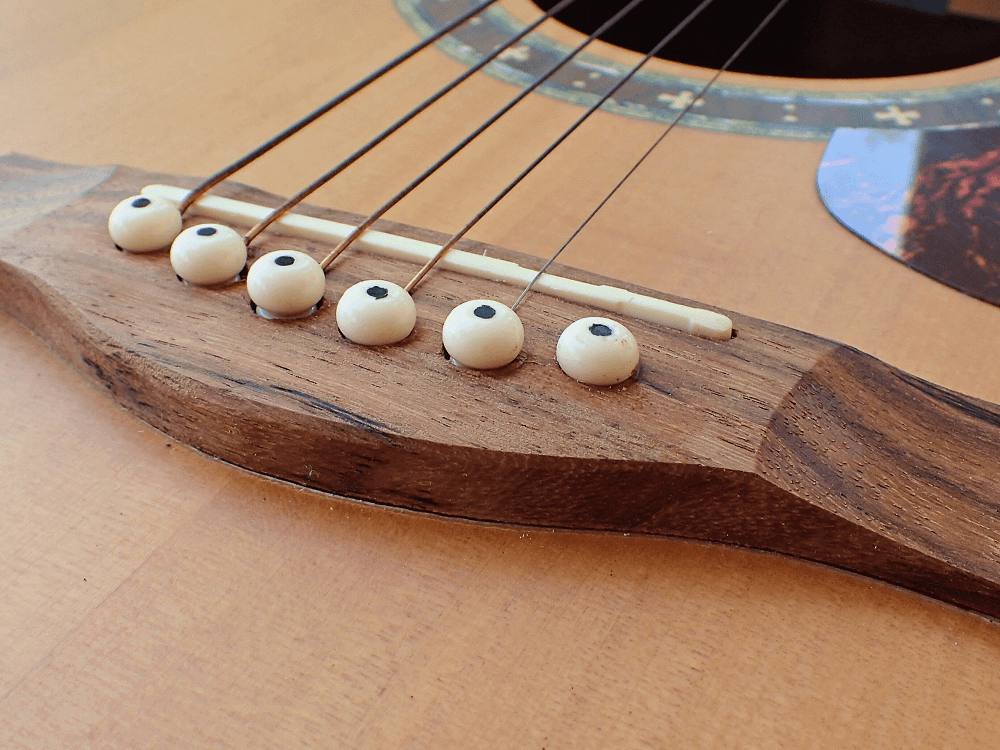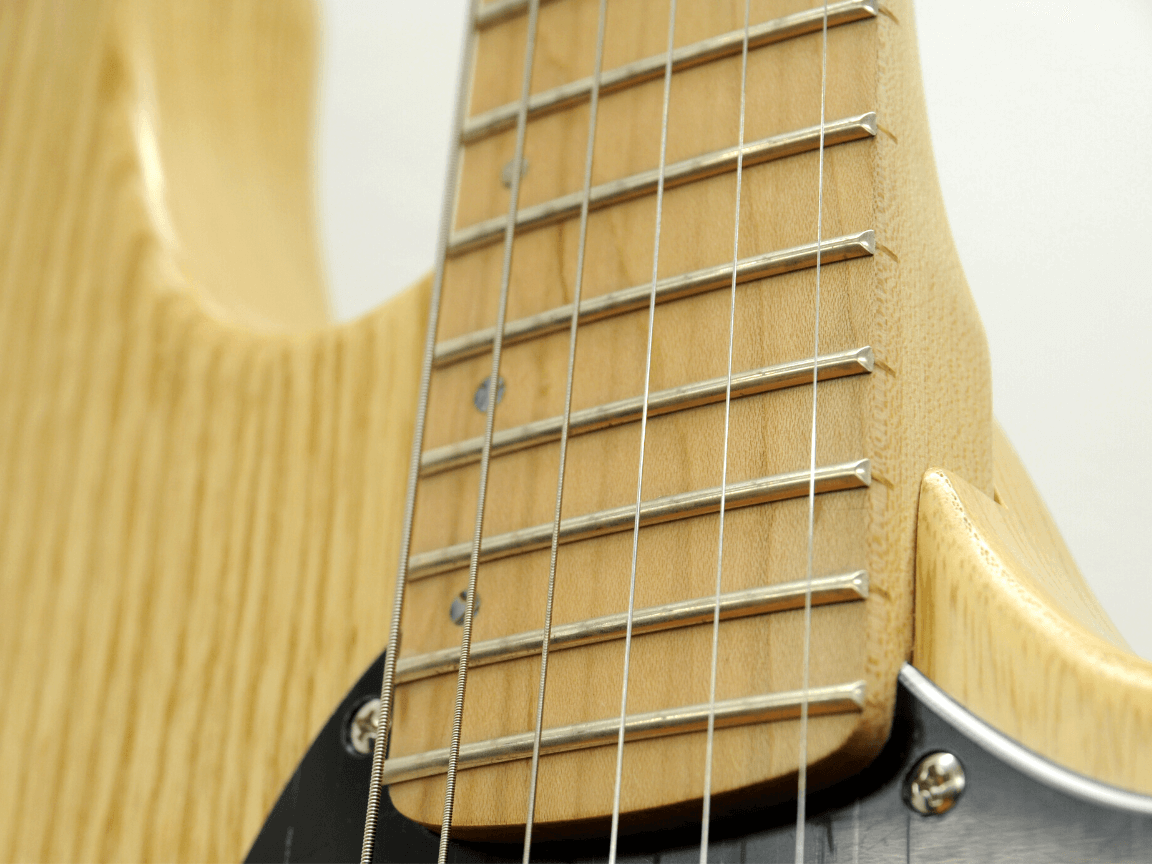If you’re a guitar player, you know how important it is to keep your instrument in top shape at all times.
But have you ever thought about the strings?
Sure, you change them when they break or go out of tune, but can guitar strings actually go bad?
Let’s say you don’t play guitar for six months, but had put in new strings before you stopped playing.
Will they still be good to start playing? What changes in them throughout that time?
In this article, we’ll discuss the signs that your strings are no longer up to par and what you can do to keep them in good condition.
We’ll also cover the different types of strings, how often to change them, and how they affect the sound of your guitar.
Table of Contents
- Can guitar strings go bad?
- What causes guitar strings to go bad?
- How to tell if your strings are going bad?
- How to prevent guitar strings from going bad?
- How to replace guitar strings?
- Different Types of Guitar Strings
- How long does it take for guitar strings to go bad?
- Do old strings sound worse?
- How often do professional guitarists change strings?
- Is it true that heavier strings stay in tune better?
- How do expensive guitar strings make a difference?
- Do unopened guitar strings have a shelf life?
- Final thoughts
Can guitar strings go bad?
Yes, guitar strings can go bad. Over time, the strings can corrode, lose their tone, and become difficult to tune. Also, if the strings are not properly cared for (wiped down after playing, etc.), they can become dirty and less responsive. Lastly, playing the strings too hard can cause them to break or become more prone to breaking.
There are many other factors that can lead to bad strings, such as climate and humidity.
If the strings are exposed to extreme humidity or dryness over a period of time, they can become brittle and break easily.
Also, strings that are kept on the guitar for too long can start to show signs of wear, as in scratches or corrosion.
Let’s take a look at some of the things that cause strings to go bad and what you can do to prevent this from happening.
What causes guitar strings to go bad?
So, now that you know the basics of guitar strings and how they can be affected, what causes them to go bad?
There are several factors that can affect the longevity of your strings, such as:
1. Corrosion
Guitar strings can go bad for a variety of reasons, but the most common causes are corrosion, environmental factors, and poor-quality strings.
Corrosion occurs when the strings are exposed to moisture, sweat, and dirt, which can cause them to rust and weaken over time.
On top of that, electrolytic corrosion can occur when the strings come into contact with metal objects, like picks and frets.
Also, when you put coated strings on an instrument, they can often corrode faster due to their protective coatings.
So make sure to keep your strings clean and dry, especially if you’re playing in a humid or damp environment.
2. Poor Quality Strings
The quality of the strings you buy will also have a big impact on their longevity.
Cheap strings are usually made with lower-grade materials, which means they’re more prone to breakage and corrosion than higher-end strings.
It most likely won’t matter with a beginner, but an experienced musician might want to invest in higher-quality strings.
Although you can take care of them as much as possible, even the best strings will eventually need to be replaced.
On top of that, whether the strings are coated or uncoated, wound or plain makes a difference in how quickly they wear out.
3. Environmental Factors
Environmental factors such as extreme temperatures and humidity can also cause strings to go bad, as the metal can expand and contract, leading to breakage.
The temperature can also affect the tuning of your strings since the metal will expand and contract when exposed to extreme temperatures.
Humidity is another factor that can affect the lifespan of your strings, as it causes corrosion and rust.
For the most part, you won’t be able to control the environment, but you can make sure that your guitar is kept in a temperature-controlled room and away from moisture.
Even though the difference can be subtle, keeping your strings in good condition will help extend their life and improve your playing experience.
4. Age
Just like all other things, guitar strings don’t last forever.
Over time, the metal in the strings will wear down, leading to breakage and poor sound quality. Additionally, if your strings have been on for a long time without being changed or tuned, they can become corroded and brittle due to environmental factors.
So, it’s important to remember to change your strings regularly and keep them clean and in good condition.
At the same time, it’s important to remember that your strings will eventually need to be replaced, no matter how much you take care of them.
5. Poor Technique
Lastly, improper playing technique can cause strings to go bad faster.
If you’re not used to playing guitar, it’s easy to put too much pressure on the strings or accidentally hit them hard with a pick or other object.
This can lead to breakage and poor sound quality over time if done repeatedly.
One of the best ways to make sure you’re not damaging your strings is to practice good technique and always use the right tools.
If you’re a beginner, it can be helpful to get guidance from an experienced teacher or musician and to get familiar with the basics of guitar playing.
This will help you take better care of your strings and improve your sound in the long run.
How to tell if your strings are going bad?
So, you just replaced your strings and want to know if they’re still in good condition?
Here are some signs that your strings might be going bad:
1. Loss of Tone
If you notice that your strings are losing their tone or vibrating differently than before, it could be a sign that the strings are starting to wear down.
Something to look for is a dull, lifeless sound coming from the strings when you play.
This could mean that the tone has deteriorated due to age or environmental factors and that the vibrations of the strings are no longer as strong.
2. Fret Buzzing
Another sign that your strings might be going bad is an increase in fret buzzing.
Fret buzzing usually occurs when the string becomes loose or worn and can lead to poor intonation and tuning issues.
Be sure to check for uneven frets, improper string tension, and/or worn strings, as these can all contribute to fret buzzing.
If all of a sudden you notice an increase in fret buzzing, it’s a good idea to check for worn strings and/or adjust the string tension to see if that helps.
3. Slippage/Breakage
Now, you may notice that your strings are slipping or breaking more easily than usual.
This can be a sign that the strings have become worn down and need to be replaced.
What you can do is check for any signs of corrosion and make sure that the strings are at the right tension.
If you find that they’re still slipping frequently, it may be time to get new strings!
Try to time how often this happens, so that you can have an idea of when to replace your strings in the future.
4. Discoloration
On the other hand, one sign that your strings might be going bad is discoloration.
This can happen due to environmental factors, such as humidity or sweat from your hands, and will cause the string’s color to fade or become darker over time.
If you notice any changes in color or tone, it may be a sign that the strings need to be replaced.
Acoustic guitar strings are particularly susceptible to discoloration, so keep an eye out for any changes in color.
How to prevent guitar strings from going bad?
To prevent guitar strings from going bad, it’s important to always keep them clean and dry. Regularly wiping down the strings with a soft cloth can help remove debris that could cause corrosion or rust.
Additionally, storing your guitar in a case when it is not being used will help protect the strings from dirt, dust, and other environmental factors that could lead to string damage.
Let’s take a closer look at some of these things in more detail:
1. Clean and apply the right products to it
Keeping your guitar strings clean and oiled is one of the most important steps in preventing them from going bad.
To clean them, you can use a soft cloth or a cotton swab to wipe away any dirt and grime.
After cleaning, you should apply a light oil such as mineral oil or guitar string lubricant to keep them from drying out and becoming brittle.
What this does is that it helps prevent corrosion and rust from forming on the strings, which can cause them to become brittle and eventually snap.
2. Store them somewhere safe
When not in use, it is important to store your strings properly so that they stay in good condition.
Storing them in a case or a box with a lid is the best option, as this will protect them from dirt and dust that could cause string damage.
It is also important to make sure that the strings are not exposed to extreme temperatures or humidity as these environments can cause corrosion and rust to form on the strings.
On top of that, it is also a good idea to keep the strings away from direct sunlight as this can cause them to become brittle and weaken over time.
By following these simple steps, you will be able to ensure that your guitar strings stay in great
3. Changing and replacing them regularly
Replacing your strings regularly is another important step in preventing them from going bad.
Depending on how often you play, you should replace your strings at least once every three months.
Replacing them earlier if they start to sound dull or feel slippery can also help to prevent corrosion and rust from forming on the strings.
When replacing your strings, make sure to use the same type that you were using previously as different types of strings require different amounts of tension and can affect your guitar’s sound quality.
How to replace guitar strings?
Replacing guitar strings is an important part of regular maintenance for any guitar.
It can help keep your guitar sounding its best, and it’s an easy process that anyone can do. Here’s a step-by-step guide on how to replace guitar strings:
1. Remove the old strings
The first step is to remove the old strings that you currently have.
You can do this by loosening the tuning pegs until the strings are slack and then carefully pulling them off.
Make sure to save the old strings, as they can come in handy if you ever need a quick replacement or feel like experimenting with different types of strings.
2. Wind the new strings onto the pegs
The next step is to take your new strings and wind them onto the tuning pegs, starting from the sixth string and working your way up to the first string.
When winding the strings, make sure that they are snugly wound and that there are no gaps or slack in between the windings.
Start by threading the ball end of the string through the bridge, then pull the string up to the headstock.
Make sure to leave enough slack in the string so it’s easy to work with and be able to tune it without any issues.
You can either choose to tune one by one or wait until all of them are placed before you start tuning.
3. Tuning the strings
After the strings are all in place, it’s time to tune them up to the correct pitch.
You can use a digital tuner or an app on your smartphone to help you out with this step.
Start by tuning the sixth string, then move up one string at a time until all of them are in tune.
If the strings sound too loose or too tight, adjust the tuning pegs accordingly until they are in the right pitch.
4. Cut off the extra string ends
Once you’re done tuning, it’s time to cut off the excess string ends that are sticking out from the headstock.
Depending on the type of strings you’re using, you may need to do some extra winding on the pegs to make sure that all of the string ends are tucked away.
Once everything is in place, give the strings one last check to make sure they’re all in tune and then you’re good to start playing.
It’s important to remember that replacing your guitar strings regularly will help keep them in good condition and ensure that you’re getting the best possible sound out of your instrument.
With just a little bit of knowledge and some basic tools, you can easily replace guitar strings yourself and get back to playing in no time!
Different Types of Guitar Strings
Guitar strings come in a variety of materials, sizes, and tensions, so it can be difficult to know which type of string is best for your guitar and playing style.
The most common types of guitar strings are made from steel, nylon, or a combination of the two.
Steel strings are the most popular and offer a bright, powerful sound, while nylon strings are known for their softer, mellower tone.

They come in a variety of gauges, or thicknesses, which affect the tension and sound of the strings.
For example, thicker strings are usually heavier and produce a louder, fuller sound, while thinner strings are easier to play and produce a brighter, more delicate sound.
Nylon strings are usually found on classical and flamenco guitars, and they come in a variety of tensions as well.
These strings produce a warm, mellow sound and are easier to play than steel strings since they’re easier on your fingers and allow you to fret them with ease.
How long does it take for guitar strings to go bad?
It really depends on how often you play your guitar and how well you take care of your strings.
If you’re playing your guitar every day, you should expect to change your strings every few weeks.
If you’re playing less frequently, you can probably get away with changing your strings every few months.
It’s also important to make sure you keep your strings clean and dry, as dirt and moisture can cause them to corrode and go bad more quickly.
If you’re a beginner, you may want to check your strings every few weeks to make sure they’re still in good condition.
Ultimately, it’s important to remember that strings are one of the most important components of your guitar, so taking proper care of them is essential to ensure you get the best sound possible.
Do old strings sound worse?
It’s a common belief that old strings sound worse than new strings, and while this can sometimes be true, it’s not always the case.
The sound of strings is affected by a variety of factors, including the type of string material, the gauge of the string, the age of the string, and the environment in which the strings are being used.
Generally speaking, strings that have been used for a long time will have lost some of their brightness and resonance, as the metal has been worn down over time.
However, if the strings have been kept in a clean, dry environment, they may still sound good.
Additionally, some players prefer the mellower sound of older strings, as they feel it’s more suited to their playing style.
Ultimately, the sound of the strings will depend on the individual player and their preferences.
How often do professional guitarists change strings?
Professional guitarists typically change their strings anywhere from once a week to once a month, depending on how often they play and the type of strings they use.
For example, if they are playing a lot of gigs and/or recording, they may want to change their strings more often to ensure they always sound their best.
On the other hand, if they are just playing casually, they may be able to get away with changing their strings less often.

Additionally, the type of strings used can also affect how often they need to be changed.
For instance, coated strings can last longer than uncoated strings, so a guitarist may be able to go longer between string changes if they use coated strings.
Ultimately, it’s up to the individual guitarist to decide how often they want to change their strings, but it’s generally recommended that they do it at least once a month.
Is it true that heavier strings stay in tune better?
Yes, it is true that heavier strings stay in tune better.
This is because heavier strings have a higher tension, which means they are less likely to go out of tune when played.
Heavier strings also vibrate more slowly than lighter strings, which helps them to stay in tune for longer periods of time.

Additionally, heavier strings have a thicker gauge, which means they are less likely to break or become damaged when played.
While heavier strings do stay in tune better, they can be harder to play and may require more finger strength.
They also require more energy to get them vibrating, which can be tiring for some players.
Ultimately, the choice of string gauge comes down to personal preference, as some players may prefer the sound of heavier strings, while others may prefer the feel of lighter strings.
How do expensive guitar strings make a difference?
Expensive guitar strings can make a huge difference in the sound and playability of your instrument.
They are usually made of higher quality materials, such as nickel-plated steel or stainless steel, which provide a brighter and more consistent tone.

They also tend to last longer than cheaper strings, so you can play for longer without having to replace them.
Expensive strings also tend to be better at holding their tuning, so you won’t have to tune as often.
Finally, they provide a more comfortable playing experience, as they are usually smoother and more flexible than cheaper strings.
All of these factors combined can make a huge difference in the overall sound of your guitar.
Do unopened guitar strings have a shelf life?
When it comes to unopened guitar strings, they do have a shelf life.
It’s important to note that the shelf life of a set of strings is dependent on the type of string and the environment in which it is stored.

For example, if the strings are stored in a humid environment, the shelf life of the strings will be significantly shorter than if they were stored in a dry environment.
Generally speaking, unopened guitar strings can last anywhere from one to three years, depending on the type of string and the environment in which it is stored.
It’s important to check the packaging of the strings for an expiration date and to store the strings in a dry, dark place to ensure they last as long as possible.
Final thoughts
Overall, it is important to be aware of the signs that your guitar strings have gone bad.
If you notice any of the signs discussed in this article, such as a dull sound, a decrease in tuning stability, or a decrease in string tension, it is important to replace your strings as soon as possible.
Replacing your strings regularly is the best way to ensure that your guitar is always in top condition and that you can enjoy playing it to its fullest potential.
With a little practice, you can learn how to tell if your guitar strings have gone bad and take the necessary steps to keep your guitar in great shape.

More than 10 years of experience playing and writing about guitars! When not writing, I can be found strumming away some Johnny Cash tunes. Favorite all time guitar is the Gibson Les Paul. #TeamGibson




